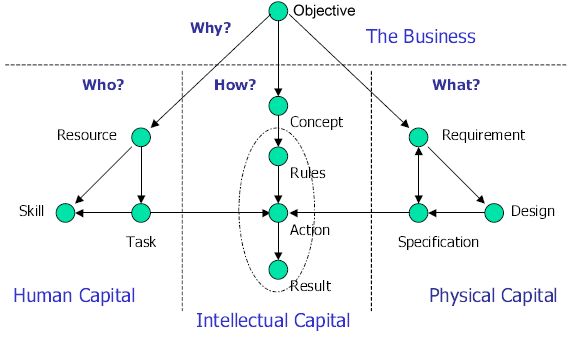dita-busdocs message
[Date Prev]
| [Thread Prev]
| [Thread Next]
| [Date Next]
--
[Date Index]
| [Thread Index]
| [List Home]
Subject: comments on Rob Hanna's white paper
- From: "Bruce Nevin (bnevin)" <bnevin@cisco.com>
- To: <dita-busdocs@lists.oasis-open.org>
- Date: Thu, 7 Aug 2008 17:14:01 -0400
Here are a few comments that I noted while reading
Rob's white paper. First his diagram, for reference, slightly edited (the image
is also attached). Might consider making more of the arrows bidirectional; the
loop from Result to Objective is omitted (comment below).
1
Objective
The label on
the "Objective" node was
missing.
2
Resource, 3 Task, 4 Skill -- No
comments.
5 Concept
"The
concepts object defines the complete set of
terminology used within the
environment. Terms defined
here can be used throughout the
environment."
This is merely a
glossary of terms. The notion seems to be that the definitions of terms that
are essential to the domain are statements of (all the?) concepts that are essential to the
domain. However,
this perhaps debatable contention is not explicitly stated.
Certainly, it is necessary to master the terminology and
the definitions of objects and relations of a field. Many a glib shyster has
"passed" on no more substantial skill than that--until they have to actually do
or produce something. Typically, a definition in a domain is stated in the
sublanguage of a logically prior domain.
Other
conceptual information is in the Rules,
Requirement, Specification, and Design objects, then? What of conceptual
information associated with a process, a procedure, or an
action?
6
Rules-- no comments.
7 Action
"Actions [sic] objects include processes, procedures, instructions, and test plans." Nodes in the "human capital" and "physical capital"
triads must correspondingly shift scope, and they must also scale insofar is a
process is a sequence of procedures (or potentially a sequence of
processes).
8
Result
[...]
"While it appears as a terminal node in the model, it
can
ultimately link back directly to a new objectives object."
The link back is not
shown. This could also be represented as one such pyramidal tree atop
another, the result of the one above linking to the objective of the one below.
In addition, an
objective is a desired result. Consequently the successful result of an action
has a substantial relationship to the objective which motivates that action. This may be so
in a qualified way
even when the result differs from the objective, although in a troubleshooting
process such a "failure" result links to the objective of a different objective and task,
possibly with a
different resource.
The example of test
results falls here. However, the expected results or "pass
criterion/criteria" of a test are not the objective of the test. The
business objective of testing is to determine whether a product is ready to release and, if
not, some indication of what specific additional work is required. (Developers often do additional
testing to pin down a bug.)
This is a result in
the sense of accomplishment. But examples also include scenarios and incident
descriptions, and these are not accomplishments. They may be consequences of actions, but
those actions are
fortuitous, unplanned, not organized systematically with the marshalling of
resources etc. to achieve an objective.
A scenario may give
rise to or motivate or contextualize an action, a task, or even an objective. Does that call for a
double-headed arrow
between result and action? Between result and task? The consequences of an
action or actions may be described in a scenario which may then motivate the formulation of new
objectives. Or is
some other definition of scenario intended?
An incident
description may describe consequences of actions, but not purposefully intended
results achieving a business objective. It may be akin to negative test results, without the
context of a formal
test.
9
Requirement, 10 Design, 11 Specification -- no comments. (But should it not be
"Requirements"?)
____________________________________________
The stated
purposes:
As content developers
"We capture information
provided by subject matter experts as it changes.
We
then transform it into content and publish it to our users.
Yet when we
talk about single-sourcing, most often we
are talking about managing our own
content. If we were
able to single source information rather than content
we
could get closer to the source and interact directly with
the agents of
change within the organization. The
challenge is in finding a way to
effectively manage
information as content.
[...]
"Language, format,
media, audience, and even derivative
content are all part of the presentation
layer. They can
all change according to the needs of our users.
The
underlying information however stays the same
regardless of changes to
the presentation layer.
[...]
"Experts
argue that accidental reuse is
not practical – and this I
would agree is mostly true of content. But it is
not
strictly true of information. Information should not
change according
to its context.
[...]
The aim is "a model that attempts to
define the
shape of information we use to
create
documentation".
____________________________________________
This statement
overreaches a bit. These are information types or metadata category labels for
(like it or not) content.
When Dick Kittredge's
products (cogentex.com) generate fluent text in a variety of languages and
output modularities, the non-language data sources are arguably information as
distinct from content.
Harrisian discourse
analysis produces a representation of information in a constrained
subject-matter domain.
RHannaModel.tif
[Date Prev]
| [Thread Prev]
| [Thread Next]
| [Date Next]
--
[Date Index]
| [Thread Index]
| [List Home]

